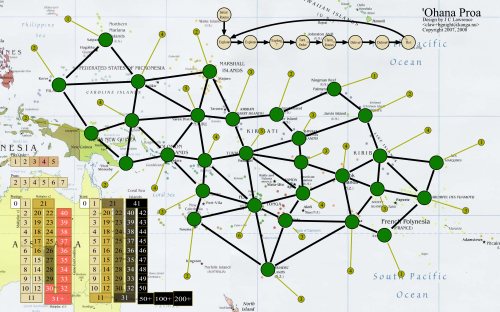In a recent comment Ben Keightly argued that ‘Ohana Proa both is and should be a resource management game, and to an extent he’s right. And wrong – well, if not-what-I-want can be accounted as incorrect then he’s wrong. Ultimately all games are resource management games: players have a variety of fungible resources, abilities and opportunities to exercise them during the game and the player that manages the use of their resources, abilities (really just another resource) and opportunities (yet another resource) most effectively will (should) win. Ergo all games are resource management games and it is thus a uselessly global and tautological definition.
At a lower and more useful altitude I define resource management games as games in which the resources in question are (generally) enumerable, limited, and usually highly granular. At heart resource management games are exercises in scarcity. At a crude character level players must mete and dole and shave their pennies while still accomplishing the victory conditions. However, that’s not my interest or goal for ‘Ohana Proa. I’m not interested in ‘Ohana Proa being a game of managing scarcity, rather it is intended to be (and is) a game of jocund excess. The resources I’m interested in players managing are not discrete enumerable elements of fish and shells and VPs and kula, but of opportunities and mutual player (dis)incentives and posture. Any reasonable player in ‘Ohana Proa will have more fish and shells and kula etc than they necessarily know what to do with, they are going to be fundamentally rich and they are going to stay rich if they pay even marginal attention.
Being rich is not the problem. Spending the wealth is not the problem (there’s always the turn order auction for that). The problem is simple: prestige. To get prestige the players must individually create and sustain situations in which the other players consistently give them disproportionately more than they give each other. It really is that simple. You have, more or less, all the wealth of the world, you are rich, but there’s a strict protocol for prestige-generating gifts and you need to manipulate the system so that you get to give more, more efficiently, than the other players. There’s a big machinery behind that prestige-giving protocol. There’s routes and auctions and fish and shells and kula and rot and a whole mess of details, all of which, Ben is quite right here, are almost busywork details.
There’s a common (and false) stereotype of rich people’s visiting gifts being things like a small pot of hand-made jam or the like (recently reiterated in Six Degrees of Separation, a wonderful movie BTW). ‘Ohana Proa perpetuates this sorry model except that now the players have to grow their own berries, pick their own fruit (for themselves or each other), boil their own mixtures and in general go through a whole big and somewhat extraneous ritual just to get the little jar of hand-made jam to give their friends when they visit. But they have lots of friends and managing (there’s that word again) both the production pipeline of jam (kula) and the rate of opportunities to deliver (density of deliveries to islands connected by multiple players) as a set is difficult and the heart of the game.
Ahh, so there are resources to manage: the kula production pipeline and deliveries to multiply connected islands! Too true! Those are the primary resource challenges of the game, which makes it kinda sorta a resource management game except that the primary resources are:
- Opportunities to make deliveries to islands which are connected by multiple other players
- Network meshes that generate sufficient resource flow to afford those opportunities
And those things are not generally enumerable, particularly limited (scarce) or granular. They are more akin to diffusive field effects. Yeah, at a grand-level it is all busywork. All the little fish and shell etc stuff is noise, but it is important noise. It is busywork that builds the stuff that starts the multi-step inferential pipeline that establishes the incentives for the players to emergently create those opportunities and network-properties for your personal victory.
Quoting Ben again:
The way markets and kahunas interacted with the network is so interesting. It
reminded me very strongly of the illustrations you sometimes see depicting
gravity, with large planets sagging the 2D space-time grid. The way these
interactions worked was clear as day. Unfortunately we were watching them
happen from behind a pane of glass, and not consciously participating in the
process.
Again, he’s right. My challenge is to diffusively but yet tangibly connect the players with that rubber sheet. I think, hope, that the recent rules changes, especially finishing splitting kula and damping the effect of kahuna will help make that diffuse connection more tangible.
